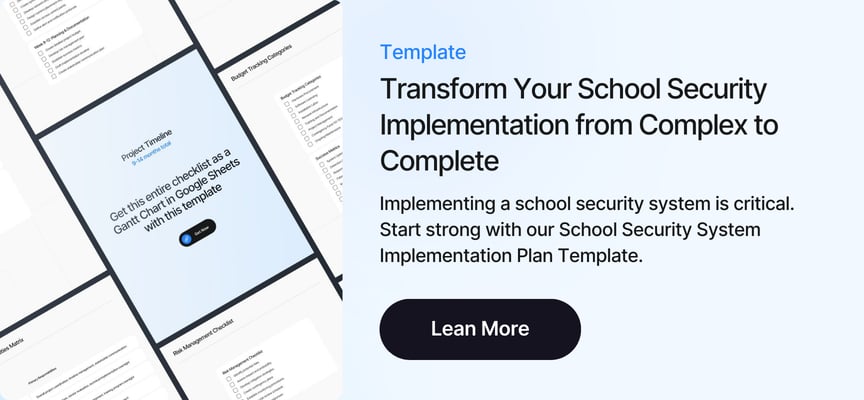Key Points
- Comprehensive safety culture: Goes beyond policies to embed security awareness into daily operations and community mindset, creating safer schools through shared responsibility
- Multi-layered approach: Combines technology, training, communication, and community engagement for maximum effectiveness in school safety programs
- Proactive prevention: Shifts focus from reactive incident response to identifying and addressing potential risks before they escalate into serious safety concerns
- Technology integration: Modern AI-powered systems enhance human capabilities while maintaining privacy and supporting educational goals for improved safety in schools
- Continuous improvement: Regular assessment, feedback collection, and strategy refinement ensure evolving safety measures meet changing needs and maintain effective school security
What Does Safety in Schools Really Mean? Transforming from Reactive to Proactive
Safety in schools encompasses far more than installing security cameras and conducting lockdown drills. True school safety emerges from a comprehensive culture that permeates every aspect of the educational environment, from daily interactions to emergency preparedness protocols.
According to the National Center for Education Statistics, 93% of public schools use security cameras to monitor their campus, yet many institutions still struggle with creating comprehensive safety cultures. This cultural transformation positions safety as a shared responsibility rather than a burden carried solely by administrators and security personnel.
When implemented effectively, a robust safety culture enhances the learning environment while providing the protection students, staff, and families deserve. Understanding why school safety is important helps administrators recognize that the most successful approaches to safety in schools integrate multiple strategies that work together to create truly secure educational environments.
Read the full school safety guide.
Foundation Elements of Effective School Safety Culture
Leadership Commitment and Visibility in School Safety Programs
School safety culture begins at the administrative level, where visible leadership commitment sets the tone for the entire educational community. Administrators must demonstrate that safety considerations influence every major decision, from budget allocations to curriculum planning.
Research shows that schools with strong administrative support for safety initiatives experience significantly better outcomes in creating secure learning environments. Effective safety leadership involves regular communication about security initiatives, transparent reporting of safety metrics, and consistent follow-through on stated safety priorities. Many schools benefit from exploring school safety grants to support comprehensive safety investments.
This commitment becomes evident through dedicated resources, clear accountability structures, and ongoing professional development for staff members. School safety programs succeed when leadership demonstrates unwavering support for comprehensive security measures.
Community-Wide Engagement and Ownership for Safer Schools
A sustainable safety culture extends beyond school walls to include families, local law enforcement, and community organizations in collaborative security efforts. This broader engagement creates multiple layers of support and awareness that strengthen overall protection.
Parent education programs help families understand their role in school safety, from recognizing concerning behaviors to supporting security protocols. Community partnerships with local emergency services ensure coordinated response capabilities during critical incidents, making schools safer through collective action.
Core Components of a Comprehensive Safety Framework
Technology Integration for Enhanced Safety in Schools
Modern school safety relies heavily on intelligent technology systems that provide real-time monitoring and threat detection capabilities. These systems transform traditional security cameras into proactive monitoring tools that can identify potential issues before they escalate.
Advanced AI-powered systems can detect weapons, identify medical emergencies, and monitor for unauthorized access without compromising student privacy. The University of Illinois Chicago case study demonstrates how AI-powered video surveillance across 142 critical camera streams enabled the institution to reduce reliance on third-party security companies while improving overall campus safety.
The most effective technology solutions integrate seamlessly with existing infrastructure while providing comprehensive coverage across campus facilities, essential components of modern safety in schools. Schools seeking complete school safety solutions can benefit from understanding how modern technology integrates with traditional security approaches.
Technology Component | Primary Function | Safety Benefit |
AI-Powered Video Analytics | Real-time threat detection | Immediate identification of weapons, fights, medical emergencies |
3D Facility Mapping | Spatial awareness and tracking | Precise location data for emergency response |
Automated Alert Systems | Instant notification protocols | Rapid communication to security teams and first responders |
Integration Capabilities | Unified security ecosystem | Seamless operation with existing camera infrastructure |
How Traditional vs. Modern Safety Approaches Impact School Security
The evolution from reactive to proactive safety measures represents a fundamental shift in how schools approach security challenges. Understanding these differences helps administrators make informed decisions about implementing comprehensive safety cultures and balancing protection with learning environment needs.
Traditional Approach | Modern Comprehensive Approach | Cultural Impact |
Post-incident investigation | Real-time threat prevention | Proactive community engagement |
Manual monitoring systems | AI-powered continuous surveillance | Enhanced staff confidence |
Isolated security measures | Integrated technology ecosystem | Coordinated response capabilities |
Limited stakeholder involvement | Community-wide safety participation | Shared responsibility mindset |
Reactive policy enforcement | Preventive intervention strategies | Supportive educational environment |
Training and Preparedness Programs for School Safety Excellence
Comprehensive safety culture requires ongoing education that prepares all community members to recognize, respond to, and report potential security concerns. Regular training sessions ensure everyone understands their role in maintaining a secure environment and contributing to overall safety in schools.
Staff development programs should cover threat recognition, de-escalation techniques, and emergency response protocols. Student education focuses on peer support, reporting mechanisms, and personal safety awareness without creating anxiety about school attendance. Effective safety drills for schools ensure that training translates into coordinated emergency response capabilities.
According to the Prescott High School implementation, comprehensive training combined with AI-powered detection systems enabled staff to respond to medical emergencies within 15 seconds and address potential conflicts before they escalated.
Effective training programs include:
- Scenario-based exercises: Realistic simulations that prepare staff for various emergency situations affecting school safety
- Regular skill updates: Ongoing education to maintain proficiency in safety protocols and technology use
- Cross-functional coordination: Training that emphasizes collaboration between different school departments and external partners
- Student engagement programs: Age-appropriate safety education that empowers students as active participants in school security
Communication Strategies and Protocols for School Safety Success
Clear, consistent communication forms the backbone of any effective safety culture, ensuring that important information reaches the right people at the right time. Communication protocols must address both routine safety updates and emergency notification procedures for optimal safety in schools.
Regular safety communications help maintain awareness and reinforce the importance of security measures. These updates should highlight positive safety outcomes, recognize individual contributions to school security, and provide transparent reporting on safety metrics and improvements.
Emergency communication systems require redundant channels and clear escalation procedures to ensure critical information reaches all stakeholders during crisis situations. Mobile notification systems, public address capabilities, and direct law enforcement connections provide multiple communication pathways essential for comprehensive school safety programs.
Advanced Safety Strategies for Modern Threats
Behavioral Threat Assessment and Intervention in School Environments
Proactive safety culture includes systematic approaches to identifying and addressing common safety problems in schools before they escalate into serious incidents. Threat assessment teams bring together educators, counselors, and security professionals to evaluate potential risks and coordinate appropriate interventions.
These multidisciplinary teams focus on connecting struggling students with appropriate support resources rather than simply implementing punitive measures. Early intervention strategies address underlying issues that may contribute to concerning behaviors while maintaining a supportive educational environment and promoting overall safety in schools.
Physical Environment and Access Control for Enhanced School Security
Strategic design and management of the physical school environment contribute significantly to overall safety culture. Clear sightlines, controlled access points, and well-maintained facilities support both security operations and daily educational activities.
Access control measures should balance security requirements with the welcoming atmosphere essential for effective education. Visitor management systems, secure entry protocols, and strategic facility design create multiple layers of protection without creating a prison-like environment.
Physical security enhancements include:
- Controlled entry systems: Secure main entrances with visitor management and identification verification
- Strategic landscaping: Clear sightlines and natural barriers that support security monitoring
- Interior design considerations: Layouts that facilitate supervision while maintaining comfortable learning spaces
- Emergency communication infrastructure: Strategically placed notification systems and communication devices
Mental Health and Social Support Integration for Comprehensive School Safety
Comprehensive school safety recognizes the critical connection between student wellbeing and overall security. Mental health support services, peer counseling programs, and social-emotional learning initiatives address root causes of many safety concerns.
These support systems help identify students who may be struggling with personal challenges that could affect their behavior or decision-making. Early identification and intervention prevent many potential security issues while supporting student success and wellbeing, creating a foundation for sustained safety in schools. Developing comprehensive safety plans for schools ensures these support systems are properly integrated into overall security strategies.
Technology Implementation and Staff Adaptation for Effective School Security
Successfully integrating advanced safety technology requires careful attention to staff training and change management processes. Technology adoption succeeds when administrators prioritize user education and provide ongoing support for system utilization.
Staff members need comprehensive training on new safety technologies, including proper alert response procedures and system maintenance requirements. Regular refresher sessions ensure proficiency levels remain high while new features and capabilities are properly integrated into daily operations. Understanding school safety software capabilities helps administrators make informed decisions about technology investments.
Effective technology implementation strategies focus on gradual deployment, comprehensive user support, and continuous feedback collection to refine operational procedures and maintain optimal safety in schools. Advanced systems like fight detection capabilities demonstrate how AI technology can enhance traditional security approaches.
Measuring and Maintaining Safety Culture Effectiveness
Assessment Tools and Metrics for School Safety Programs
Effective safety culture requires ongoing measurement and evaluation to ensure strategies remain relevant and effective. Regular assessments should examine both quantitative security metrics and qualitative indicators of community safety perception.
Safety assessments include incident data analysis, community surveys, and professional security evaluations. These comprehensive reviews identify areas for improvement and validate the effectiveness of current safety measures, ensuring continuous enhancement of safety in schools. Schools can benefit from specialized training for school safety officers to improve assessment capabilities.
Continuous Improvement and Adaptation in School Safety Culture
School safety culture must evolve continuously to address changing threats, new technologies, and shifting community needs. Regular strategy reviews ensure that safety measures remain current and effective while adapting to emerging challenges.
Feedback collection from students, staff, and families provides valuable insights for refining safety strategies. This input helps identify gaps in current approaches and highlights opportunities for enhanced protection measures that strengthen overall safety in schools. Addressing gun safety in schools requires particularly comprehensive planning and continuous adaptation of safety protocols.
Read our Guide on Gun and Weapon Detection with AI.
Frequently Asked Questions About School Safety Culture
What are the key components of effective safety in schools?
Effective school safety includes comprehensive technology integration, staff training, community engagement, clear communication protocols, and continuous assessment of safety measures.
How can schools balance security with maintaining a welcoming learning environment?
Schools achieve this balance by implementing privacy-conscious monitoring systems, focusing on proactive prevention rather than punitive measures, and ensuring security technology supports rather than disrupts educational activities.
What role does technology play in modern school safety programs?
Modern technology provides real-time threat detection, immediate alert capabilities, and comprehensive monitoring that enhances human security efforts while maintaining privacy and supporting educational goals.
How long does it take to implement a comprehensive school safety culture?
Building effective safety culture is an ongoing process that typically shows initial improvements within 3-6 months of implementation, with full cultural integration occurring over 1-2 years of consistent effort.
VOLT AI: Your Partner in Comprehensive School Safety
Creating and maintaining an effective safety culture requires sophisticated tools that enhance human capabilities while preserving the educational environment. VOLT AI transforms existing security camera infrastructure into intelligent monitoring systems that provide real-time threat detection and response coordination.
Our AI-powered platform offers comprehensive coverage that monitors 100% of camera feeds continuously, identifying potential weapons, medical emergencies, and unauthorized access attempts. The system integrates seamlessly with existing infrastructure while providing 3D facility mapping and precise location tracking for enhanced emergency response. Schools can explore our complete school security implementation plan to understand the transformation process.
VOLT AI supports your safety culture initiatives through privacy-conscious monitoring that focuses on behaviors rather than individual identification. Human validation of all alerts ensures accuracy while maintaining the rapid response capabilities essential for effective school protection. Our comprehensive approach to protecting student safety in schools demonstrates our commitment to educational environments.
Partner with VOLT AI to transform your school safety culture with technology that understands the critical balance between security and education. Our comprehensive platform provides the intelligent monitoring capabilities that modern schools need to create truly safe learning environments where students can focus on learning and teachers can focus on teaching. Learn more about VOLT for Schools to see how we support educational institutions across the country.







